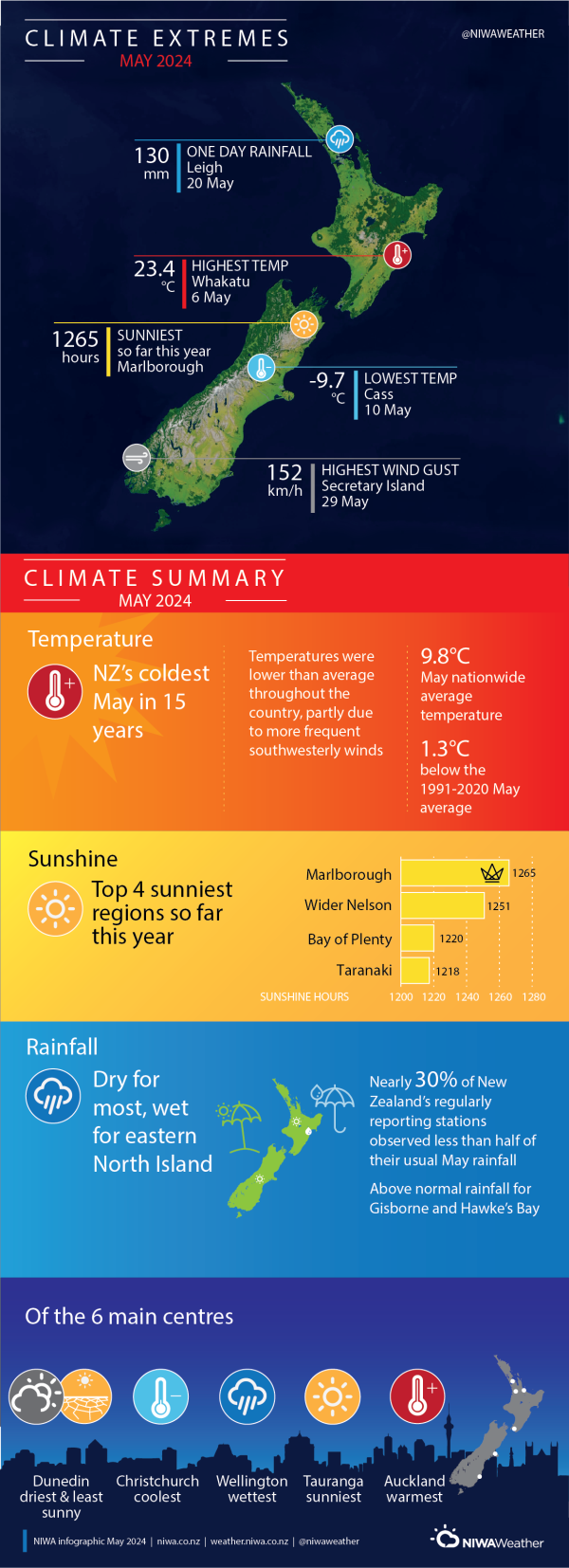| Temperature | Temperatures were below average (0.51-1.20°C below average) or well below average (>1.20°C below average) for most of the country. Overall, it was New Zealand’s coldest May in 15 years. |
| Rainfall | Rainfall was below normal (50-79% of normal) or well below normal (<50% of normal) for most of the South Island, southern and western parts of the North Island, Bay of Plenty, and parts of Waikato and Northland. Rainfall was above normal (120-149% of normal) or well above normal (>149% of normal) for isolated parts of Auckland, and eastern parts of the North Island including Gisborne, Hawke’s Bay, and southern Wairarapa. |
| Soil Moisture | At the end of May, soils were drier than normal for northern, eastern, and inland parts of the South Island, and western and southern parts of the North Island from southern Taranaki to the Greater Wellington region (excluding Wellington city). Soils were wetter than normal about Māhia Peninsula. |
Overview
May 2024 mean sea level air pressure (MSLP) was higher than normal over much of Aotearoa New Zealand and the Tasman Sea, and lower than normal to the east of the country. This resulted in more southwesterly airflows than usual over the country, and reduced mean wind speeds for many parts. These southwesterlies contributed to relatively cold temperatures for the month, with New Zealand observing its coldest May since 2009. The nationwide average temperature in May 2024 was 9.8°C. This is 1.3°C below the 1991-2020 May average from NIWA’s seven station temperature series which begins in 1909.
It was a dry month for many parts of the country. Rainfall was below normal (50-79% of normal) or well below normal (<50% of normal) for the majority of the South Island, northern and western parts of the Greater Wellington region, Manawatū-Whanganui, Taranaki, Bay of Plenty, much of Waikato, and northern and eastern parts of Northland. In contrast, rainfall was above normal (120-149% of normal) or well above normal (>149% of normal) for small pockets of Auckland, coastal Gisborne, Hawke’s Bay, and coastal South Wairarapa. Rainfall was near normal (80-119% of normal) in western parts of Northland, much of Auckland, parts of northern Waikato, Wellington, and southern Southland.
The lack of rainfall was accompanied by clear skies for many parts of the country, resulting in relatively high sunshine hours for the time of year. Tauranga and Mount Cook Village each observed their sunniest May on record. Whangārei, Paraparaumu, Franz Josef, and Queenstown observed their second-highest total sunshine hours for May, respectively.


